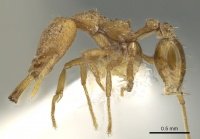Strumigenys omopyx
| Strumigenys omopyx | |
|---|---|

| |
| Scientific classification | |
| Kingdom: | Animalia |
| Phylum: | Arthropoda |
| Class: | Insecta |
| Order: | Hymenoptera |
| Family: | Formicidae |
| Subfamily: | Myrmicinae |
| Tribe: | Attini |
| Genus: | Strumigenys |
| Species: | S. omopyx |
| Binomial name | |
| Strumigenys omopyx Bolton, 2000 | |
Nothing is known about the biology of Strumigenys omopyx.
Identification
Bolton (2000) - A member of the Strumigenys omopyx-group. Of the three species currently assigned to this group two, omopyx and Strumigenys rantan, lack pronotal humeral hairs whilst the third species, Strumigenys pallentra, has a short erect stiff simple hair at each humerus. S. omopyx has the longest scapes in the group, SI 82-83, as opposed to SI 68-69 in the other two species.
Separation of omopyx and rantan is best achieved by the characters given in the key. Beside these it is worth noting that the preocular impression is much more developed in omopyx, where it is a long sweeping concavity, than in rantan where it is scarcely more than a constriction of the margins in front of the eyes.
Keys including this Species
Distribution
Distribution based on Regional Taxon Lists
Indo-Australian Region: Indonesia (type locality), Sulawesi.
Distribution based on AntMaps
Distribution based on AntWeb specimens
Check data from AntWeb
Countries Occupied
| Number of countries occupied by this species based on AntWiki Regional Taxon Lists. In general, fewer countries occupied indicates a narrower range, while more countries indicates a more widespread species. |

|
Estimated Abundance
| Relative abundance based on number of AntMaps records per species (this species within the purple bar). Fewer records (to the left) indicates a less abundant/encountered species while more records (to the right) indicates more abundant/encountered species. |

|
Biology
Castes
Nomenclature
The following information is derived from Barry Bolton's Online Catalogue of the Ants of the World.
- omopyx. Strumigenys omopyx Bolton, 2000: 897, fig. 475 (w.) INDONESIA (Sulawesi).
Unless otherwise noted the text for the remainder of this section is reported from the publication that includes the original description.
Description
Worker
Holotype. TL 3.0, HL 0.81, HW 0.63, CI 78, ML 0.40, MI 49, SL 0.52, SI 83, PW 0.33, AL 0.82. Preapical tooth small, at proximal end of concave section (apical quarter) of inner mandibular margin. Anterior clypeal margin with a broad V-shaped impression. Preocular impression in anteroventral margin of head long and broadly concave. In full-face view dorsolateral margin of head with 2-3 short stubby projecting hairs, anteriormost in apicoscrobal position; hairs directed more dorsally than laterally. With head in profile cephalic dorsum with about 6 pairs of short simple erect hairs; anteriormost hair is approximately at level of posterior margin of eye. Pronotal humeral hair absent, standing hairs absent from dorsum of pronotum; a single pair of short erect hairs present on mesonotum. Hairs on first gastral tergite simple and blunt apically, or somewhat flattened and feebly expanded toward the apex. Petiole node broader than long in dorsal view. Reticulate-punctate sculpture on disc of postpetiole partially effaced medially, not evenly densely sculptured across entire disc. Basigastral costulae shorter than disc of postpetiole.
Paratype. TL 3.0, HL 0.80, HW 0.62, CI 78, ML 0.40, MI 50, SL 0.51, SI 82, PW 0.33, AL 0.80.
Type Material
Holotype worker, Indonesia: Sulawesi Utara, G. Muajat, 1780 m., 25.i.1985 (no collector’s name) (The Natural History Museum). Paratype. 1 worker with same data as holotype. (BMNH).
References
- Bolton, B. 2000. The ant tribe Dacetini. Memoirs of the American Entomological Institute. 65:1-1028. (page 897, fig. 475 worker described)
References based on Global Ant Biodiversity Informatics
- Bolton B. 2000. The ant tribe Dacetini. Memoirs of the American Entomological Institute 65: 1-1028.

